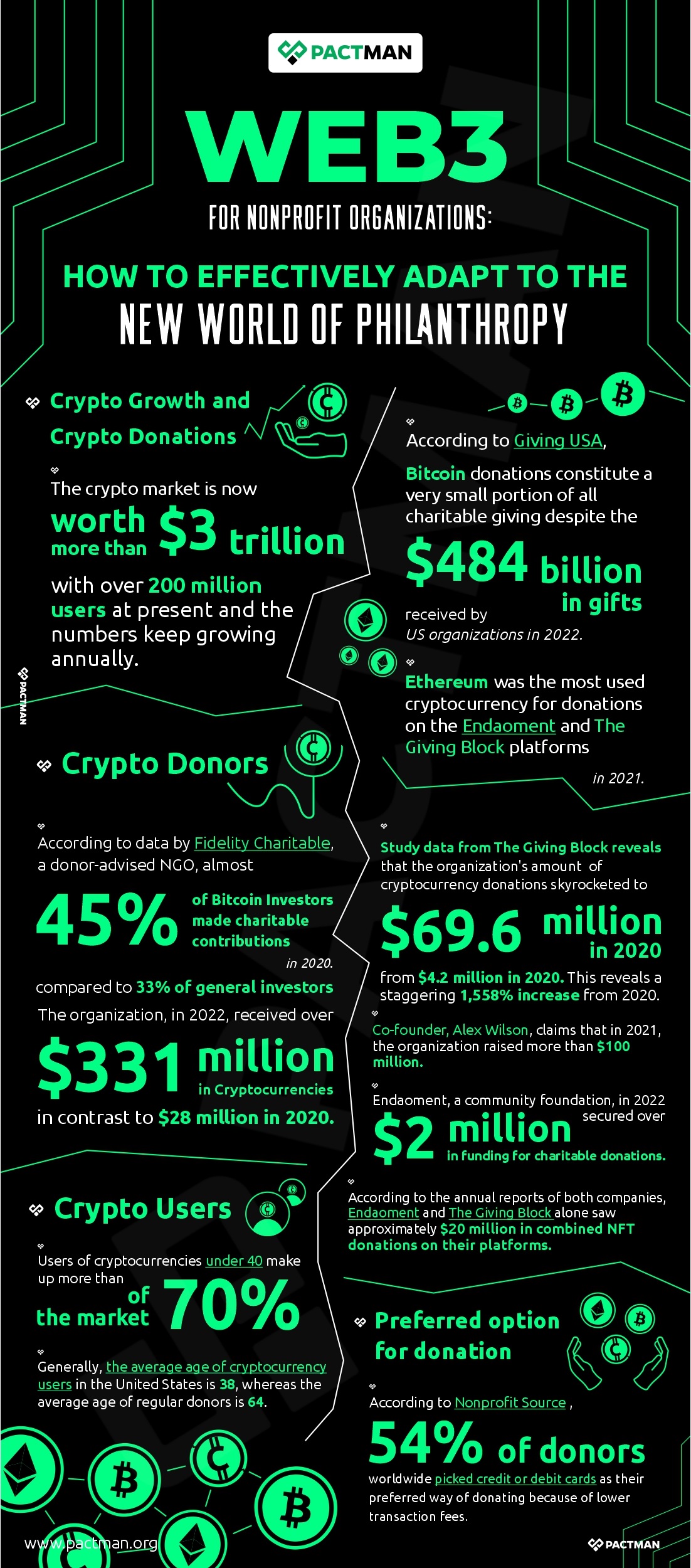I
Introduction
The Web3 industry continues to record significant innovation and in the medium term, it is anticipated to increase dramatically in size and reach. Hence, there is a need for leaders in nonprofit organizations and civil society sectors to be aware of how this technology is changing the society and economy at large. Likewise, sector leaders must critically observe how the blockchain system may change governance, programs, and funds.

Many grant funding options are available in the Web3 sector to increase the capacity of nonprofits. The crypto market as at 2021 was worth more than $3 trillion with over 200 million users at present and the numbers keep growing annually. Without a doubt, the statistics reveal significant proof that NGOs will witness a rise in the number of cryptocurrency donations. However, this is only for nonprofit organizations that have embraced Web3.
Crypto has also evolved into a crucial instrument for international contributors to support global crises. A good example is the battle between Russia and Ukraine which escalated in February 2022. The success of cryptocurrency-based fundraising initiatives in this context is indicative of a wider trend of cryptocurrency owners donating their coins to charity causes. This trend has gained significant traction which is also expected to increase in the long run.
“Early bitcoin investors are more ready to donate some of the riches they have accumulated,” says William Luther, an associate professor of economics at Florida Atlantic University. Hence, NGOs who are committed to empowering their clients should share these goals and values. A great way to begin is by having a good understanding of Web3 applications, their funding activities, payments, and programming. As Patt Duffy, CEO of The Giving Block puts it: “Any nonprofit who creates a space for crypto users outperforms the others.”
II
A Simple Definition of Cryptocurrency and Crypto Philanthropy
A cryptocurrency is a type of virtual currency that lets users send and receive money over the Internet. As opposed to Paypal or the digital banking app, this type of payment system (in general) is neither owned nor governed by a single business or entity.

The typical decentralized nature of cryptocurrencies is one distinguishing feature that has attracted millions of users. This indicates that the payment cannot be blocked or denied access by a centralized body. In simple terms, control and decision-making are shifted to disperse networks called nodes rather than remaining with a single entity, organization, or group of individuals.
Crypto philanthropy, at its core, is the act of using cryptocurrencies or assets related to cryptocurrencies for charitable giving. This is most frequently in the form of an endowment to nonprofits or other forms of giving.
The gradual switch to Web3, a version of the internet that uses cryptographic infrastructure, is only one example of how technological advancements have had a big impact on philanthropy. Smaller NGOs are now competing for donations thanks to the accessibility of crypto philanthropy, which has inspired a new generation of younger donors.
Crypto philanthropy is very different from conventional charitable donations. These variations are influencing the responses of donors, funding strategies, and even the motivations for giving. The increase in the frequency of cryptocurrency donations indicates that this kind of giving will likely continue to impact the nonprofit industry and entirely transform philanthropy.
As digital assets become more ingrained into our lives, this may only be the beginning of a new phase. The availability of crypto for giving already encourages younger people to consider philanthropy. Not to mention, smaller charities are given the opportunity to compete for donations.
III
A Brief Analysis of the Participation of Nonprofit Organizations in Web3
Many mid-sized and smaller nonprofit organizations are yet to adopt Web3 development into their activities. Although some large NGOs, given their resources and scale like Save the Children have been able to set up crypto contribution programs. According to Giving USA, bitcoin donations constitute a very small portion of all charitable giving despite the $484 billion in gifts received by US organizations in 2022.

However, the success of crypto donation campaigns to support Ukraine has demonstrated that crypto can become a very effective fundraising option for nonprofit organizations. Not to mention, this has also spurred more participation and support for other causes within the crypto community. Similar to other trends in the crypto world, participation is heavily influenced by a sense of identity and community. Smart charities are taking advantage of this cultural trend.
For instance, Alex Wilson, The Giving Block co-founder, noted that the company experienced a notable increase from its first 100 clients in 2020 to its current 1,200 clients. He also disclosed that the company is hiring more staff as they anticipate increased activities.
“It’s still pretty early days for crypto philanthropy when you think about the entire nonprofit market, but the rate at which it’s accelerating is extreme because nonprofits are realizing what a big market this is,” he added.
Ethereum was the most used cryptocurrency for donations on the Endaoment and The Giving Block platforms in 2021. Yet cryptocurrency donations weren’t simply limited to coins. Philanthropic NFT projects also gained popularity with contributors. For example, Pplpleasr, a well-known NFT artist, donated to the Stand with Asians Community Fund using the Endaoment platform.
Some sizable nonprofit organizations and international relief institutions, including The American Red Cross and Save The Children, have created systems to receive cryptocurrencies. A few others are employing platforms that facilitate their instantaneous conversion into cash. To sum up, more streams of income for charities are emerging as the largest cryptocurrencies teeter on record-high valuations.
IV
Benefits of Embracing Web3 for Nonprofit Organizations
All things considered, crypto philanthropy should be utilized by NGOs as a supplement to their standard revenue generation. This is because it has proven to be a reliable instrument, although a relatively new fundraising strategy. A few records have amply demonstrated the significant role that cryptocurrencies now play in nonprofit funding.

According to data by Fidelity Charitable, a donor-advised NGO, almost 45% of Bitcoin investors made charitable contributions in 2020, compared to 33% of general investors. The organization, in 2022, received over $331 million in cryptocurrencies, in contrast to $28 million in 2020.
Similarly, study data from The Giving Block reveals that the organization’s amount of cryptocurrency donations skyrocketed to $69.6 million in 2021 from $4.2 million in 2020. This reveals a staggering 1,558% increase from 2020. Co-founder, Alex Wilson, claims that in 2021, the organization raised more than $100 million. Endaoment, a community foundation, in 2022 secured over $2 million in funding for charitable donations.
According to the annual reports of both companies, Endaoment and The Giving Block alone saw approximately $20 million in combined NFT donations on their platforms.
The information presented above suggests that cryptocurrencies have a lot to offer nonprofit organizations. Likewise, since cryptocurrencies are typically classified as property, depending on your tax jurisdiction, donations are tax-friendly to the donor. To put it another way, bitcoin donors are exempt from reporting capital gains.
We will go further by listing the significant benefits of embracing Web3 for nonprofits.
1. More diverse donors
The simplicity of transferring cryptocurrencies makes it easy for charitable organizations to access donors from all over the world. Also, the absence of a central authority guarantees no restriction in making cryptocurrency transactions. Hence, people from all over the world are welcome to support any cause they believe in. It is no little wonder why so many global nonprofits are beginning to accept cryptocurrency donations. For instance, UNICEF introduced the CryptoFund in October 2019. Likewise, large organizations like the Red Cross and Greenpeace have also approved the use of cryptocurrency.
2. More philanthropic participation among millennials and Gen Z
On average, cryptocurrency users are substantially younger than typical philanthropic donors. Users of cryptocurrencies under 40 make up more than 70% of the market. Generally, the average age of cryptocurrency users in the United States is 38, whereas the average age of regular donors is 64.
United Way, a multinational charity organization began to accept cryptocurrency donations in 2014. The average user of the company’s website is between the ages of 45 and 65. In contrast, 80% of crypto donations on the site are given by males and females within the 25 to 35 age range. This reveals that younger people are becoming more and more involved in philanthropy through crypto donations.
3. More publicity and visibility
Young, tech-savvy crypto donors are known to support causes that are gaining wider attention online. Various cryptocurrency contribution platforms support and elicit funds that span across different sectors. This includes education, disaster assistance, food, and the environment, among others. For instance, accounts of the Russia-Ukraine war published on Twitter generated about $100 million in cryptocurrency donations to aid Ukraine.
Social media also became a COVID-19 helpline with international reach that spurred crypto donations when India battled the second wave of the pandemic.
Without a doubt, popular nonprofits have received more attention when it comes to traditional donations. Donors tend to prefer giving to large worldwide charities that are adept at publicizing their achievements. But this trend may be at the expense of smaller but no less deserving charities that also need the funding.
However, this is not the case with crypto donations. Rather than selecting a single nonprofit organization, donors can support a certain cause, with the nonprofits splitting the donation equally among themselves. Hence, smaller nonprofits are treated equally under this arrangement. This also guarantees that less well-known causes get more attention than larger and well-known nonprofits.
4. Lower transactional fees
According to Nonprofit Source, 54% of donors worldwide picked credit or debit cards as their preferred way of donating because of lower transaction fees. The processing cost on credit card transactions, which is deducted directly from the donation amount, can range from 2.2% to 7.5%, according to Charity Navigator. Likewise, a typical $2,000 wire transfer from the US to India could incur an additional $30 to $50 in processing fees.
However, by sending the same amount through the Ethereum network, the gas prices can range from $10 to $15. Additionally, there exist blockchains with significantly lower fees. Moreover, cross-border transfers of fiat currencies might take hours or even days, but transactions in cryptocurrencies can be completed in as little as a few seconds or minutes.

5. Attractive tax breaks
Crypto philanthropy may appeal to donors for a variety of reasons. Donations allow cryptocurrency investors to avoid paying capital tax gains. Giving away assets such as stock or cryptocurrency donations instead of cash might be more advantageous because it offers additional tax benefits besides the write-off.
Crypto owners would typically be required to pay up to 37% of their profit in capital gains taxes if they sold their coins after it increases in value to lock in a profit. They however don’t have to pay any capital gains tax if they give the coins in instead of selling them. The dual tax benefit explains why cryptocurrency owners, who often prefer to hang onto as much of their digital currency as possible in the hopes that it will continue to appreciate, are willing to give it away to charities rather than just making a cash donation.
Below, I will highlight an example of the correct scenario in which to donate cryptocurrencies directly to Nonprofits (Example 1), and when not to do that also (in Example 2). Note- before following any of the examples below, please consult with your CPA and/or attorney.
Example 1: Donating Cryptocurrency that has appreciated in value (after holding for at least 1 year)
Justin owns 10 bitcoins, which are tradable on the Binance Exchange. Justin paid $5,000 for the Bitcoins in 2017. Today, they are worth $600,000. Justin gives the Bitcoins to his favorite Nonprofit “We Love Red Trees and deducts the $600,000 fair market value as a charitable contribution on his taxes. Justin does not need to pay the 15% capital gains tax on $595,000 (capital gains) at the time of the donation. The nonprofit “We Love Red Trees” then sells the Bitcoins and pays no taxes on the $600,000 it receives. Justin gets to take a deduction of $595,000 on his taxes (depending on what his AGI is).
Had Justin sold the Bitcoin, he would have had to pay $89,250 long term capital gains tax on his $595,000 profit (15% X $595,000). This would have left him with only $510,750 from the Bitcoin sale to donate to the nonprofit.
Note – in the case where cryptocurrency drops in value, it makes sense to sell the cryptocurrency first before making a donation to a Nonprofit. For thoroughness, we shall also include that example too:
Example 2: Selling Cryptocurrency that has dropped in value before donation (after holding for at least 1 year)
Justin owns 10 bitcoins, which are tradable on the Binance Exchange. Justin paid $5,000 for the Bitcoins in 2017. Today, they are worth $2,000. Justin sells the Bitcoins, and then gives the proceeds of the sale to his favorite Nonprofit “We Love Red Trees. Justin is able to claim a capital gains loss of $3,000 on his taxes, and also claim a gift donation of $2,000.
Had Justin donated the Bitcoin directly to the nonprofit, he would only have been able to claim the donation of $2,000.
6. Preserves donor privacy
Targeting current donors is simpler for nonprofit organizations than finding new ones. By and large, most crypto donors frequently wish to remain anonymous. Even while donating millions of dollars, contributors can maintain their privacy. However, it’s hard to say if such anonymity might persist for very long as several nations tighten their rules on cryptocurrencies.
Understanding the many benefits of Web3 for nonprofit organizations can help you consider the opportunities that avail the industry and what it holds for your NGO if you choose to be a part of the trend.
V
How Nonprofit Organizations Can Begin Web3 Fundraising
Crypto philanthropy has firmly established itself as a dependable fundraising revenue source, propelled by the rapid rise of the worldwide crypto user base and the innovative thinking of a small but rising number of NGOs. It is definitely one of the most brilliant signs of promise for the charity industry.

Most nonprofits held virtual galas through Zoom as a sort of band-aid solution to fundraising due to the financial instability brought on by the pandemic. Other groups developed a creative, long-term plan by requesting assistance from the crypto and NFT communities.
Since the world is changing quickly, mission-driven projects must also do so. And one great way to begin is by setting up a Web3 fundraising platform.
1. Define your fundraising objective and event type
Making a decision regarding your fundraising objective and strategy. By and large, your goal for raising money may be one-time or ongoing. You can also choose from a range of fundraising strategies, such as peer-to-peer fundraising, crowdsourcing, and crowdfunding. Consider what would be best for your organization.
You may also want to go as far as creating your software on the blockchain without resorting to fundraising. However, raising money is crucial if you want to create a long-lasting company.
There are various fundraising strategies you can employ to aid your cause.
a) Sales of tokens:
Under this concept, contributors buy tokens that can be exchanged for services or have a fixed value.
b) Donations:
It is recommended to create a contribution page if your objective is to raise funds directly. Anyone can donate to your cause quickly and safely by visiting a contribution page hosted on your website.
2. Build your crypto asset
Another great option to raise money is to develop your blockchain-based currency. You can create a token using one of the numerous blockchain networks already in existence and then raise money through an ICO (Initial Coin Offering).
Also, you can develop a blockchain-based token for your nonprofit organization even if ICOs are unregulated in many nations. When you develop your cryptocurrency for fundraising, you can also deploy it for other options like rewarding your volunteers, motivating your team, and giving to charities.
Your organization can also perform microtasks like offering translation or proofreading services using your blockchain-based currency.
3. Use a DAO to promote accountability and transparency
A decentralized autonomous organization (DAO) is a management structure that uses blockchain technology to automate some aspects of voting and transaction processing. A DAO can assist your nonprofit in maintaining an open and transparent record of costs, participants, and activities. Basically, this management software can monitor your resources, outlays, and participants in an open and accountable manner.
The decentralized organization is open to anyone who wants to join and take part in its decision-making. In general, a dispersed, large-scale organization should consider a DAO. It can assist in increasing your organization’s transparency and accountability for cash raised.
4. Generate fundraising awareness through social media
The usage of social media to publicize your cause and fundraiser is highly recommended. This is accurate regardless of the type of fundraising. Social media gives you a free platform to connect with a broad audience. Not to mention, social media advertising can help attract more people to the sales of your token.
Hashtags are another tool you may use to boost participation in your campaign. You can build your website and link to it via social media. Influencers can also be used to advertise your fundraising event. They can be a powerful channel for spreading the word about your cause.
5. Use canvassing algorithms to boost involvement and engagement
Individuals love to support issues they are passionate about. You may want to improve engagement and involvement in your fundraiser by using canvassing algorithms. Employ smart contracts and blockchain technology to generate compliance and audit trails. This is one great way to raise funds more effectively. A smart contract can be programmed with a “terms of service” type of agreement. You can also set up an escrow account to keep funds until it reaches a certain amount.
6. Create your NFT for charitable giving
A Non-Fungible Token (NFT) is a special sort of token with an exclusive value. NFTs are distinct from conventional fungible tokens, such as ERC-20 tokens, which may be traded for other tokens and are interchangeable. As each token has its distinct information, using NFTs in your fundraising campaign gives you a fantastic tool to track and manage your funds. You can establish a fundraising campaign with NFTs that allows you to track funding and ownership.
NFTs for Nonprofit Fundraising are crucial because they let individuals support your nonprofit’s mission without making a single financial commitment. Even though several people may wish to help nonprofits, many are unable to financially support your organization. Giving customers virtual things they can trade, sell, or even keep for themselves can enable your company to generate fresh revenue. Virtual goods can be used as prizes for donations as well as incentives in competitions and sweepstakes.
The expansion and sustainability of an organization depends heavily on fundraising. Blockchain technology has become a more prominent tool to effectively garner donations. There are several benefits of Web3 for nonprofits not to mention improved transparency and lower expenses.
Even though the realm of cryptocurrency philanthropy may appear strange, upon receiving your first crypto donation, you begin to adapt to the ecosystem.
Without a doubt, innovation in the nonprofit sector is overdue. Industries such as agriculture, transportation, and healthcare have grown rapidly, thanks to technology. Meanwhile, nonprofit organizations continue to grapple with the challenges of improving fundraising and attracting top staff. However, NGOs can secure fundraising possibilities quickly, securely, dynamically, and transparently through the use of blockchain technology.
Conclusion
Innovative technology is practically influencing every aspect of our daily lives, including how we give to charities. Not to mention, an emerging trend in the nonprofit sector called “crypto philanthropy” is gaining ground quickly. Many astute nonprofit leaders are utilizing this innovative technology to increase fundraising and enhance their missions.
In light of this, nonprofit leaders should work to identify ways to leverage the numerous opportunities that afford cryptocurrencies to fund their missions.



One Response